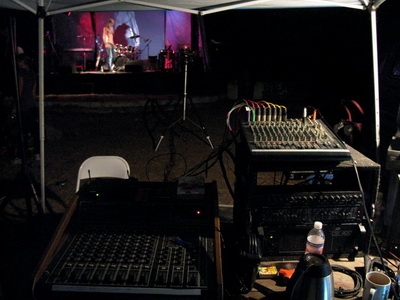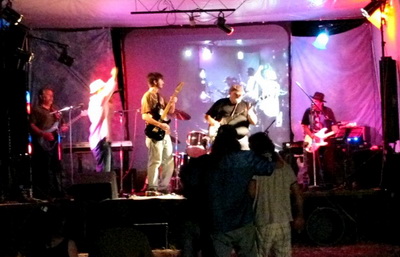I recently held a big party in my back yard, a two-day “JAM at the CAM.” I invited several bands and friends to spend the weekend playing music in the Southern California sun. It was as awesome as it sounds. We entertained my entire neighborhood and they were hollering over the fences for more. My friends had a great time and we mixed and matched and jammed out of our genres, out of our safe zones. Three generations of musicians, all flavors and colors and styles. It was a musical stretch on Labor Day weekend, the end of summer 2009, and it was great.
They didn’t know that, for me, it was a grand experiment that I had been planning for months. We produce a similar event every 4th of July and I always count on a few friends to help me pull it off. This time, my wife and I did the whole thing ourselves. We provided the stage, set up and ran the lights, the sound system, and the big-screen visuals with 5 cameras. I was also determined to sit in with every band, and she was capturing hundreds of stills.
We pulled it off all right and I learned so much. After the last July 4th and the frustration we had with BIG sound I decided to go smaller, more intimate. Loud enough to fill the back yard, which was likely to hold 150 people, plus the neighbors’ parties — each a little smaller but still good crowds. Life at the lake is like that. A smaller system meant less trouble and less crew, so I decided to go ol’ skool.
Before CDs, before the internet, before those little tiny plugs on your headphones, we managed to make good sound with a lot less trouble.
I own a PEAVEY XR-800 that I bought in 1978 with money my Granny left me. It cost 1000 bucks and has turned out to be some of the best money I’ve ever spent. I can’t tell you how many shows this particular piece of equipment has performed in. Always on, never failed and it has everything you need on-board.
It is basic and barely loud enough to do what I needed, but I was determined to prove it could be done. Using its 800 watts and on-board EQ and reverb, I mixed 5-piece bands plus “special guests” and jammers and it sounded just fine.
The setup was simple. The Peavey is only 8 channel, so I bi-amped a passive Alesis mixer inline and patched through the graphic equalizer, so the Peavey was on one side and the Alesis on the other.

I put a compressor on the mains, an external EQ and a 400-watt amp for the monitors. This let me use all 16 inputs on my snake and the three outs gave me house and monitor outputs to the stage.
Because it was totally underpowered it was a trick to keep things balanced. It worked well. If a real sound guy that does it every day ran that system it would have sounded great. I wish I was better at it but I’m not; I play the guitar. In the future I will let them do it for me.
I have said all that to say this: The sound guy, the sound check, and how the system works are all key to sounding good onstage.
As a stage performer you want to get set up quickly and you need to interact and cooperate with the sound crew to make that happen. Getting along with those people is important. Paying attention and participating in the sound check will make it easier for them to make you sound your best, really loud. That is truly what they want. When you turn your amp up too loud or switch mics in the middle of the show, you make it impossible for them to help you and you ruin the house mix that you probably can’t hear anyway.
Be aware that the first priority of a good sound guy is the house.
The monitors come second, and in a lot of places you WILL have to play as best you can without being able to hear yourself. Understand that if you play your part right and on time you should be able to play it without hearing it at all. Commit to being that rehearsed, that ready. It will help you somewhere in some dive bar that has no budget for sound.
Next week we’ll cover some other tips for getting good sound from a third party sound crew. Subscribe to BareFootMusicNews so you won’t miss it!
UPDATE: Part two is now up Click Here



